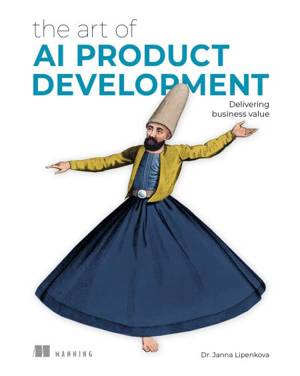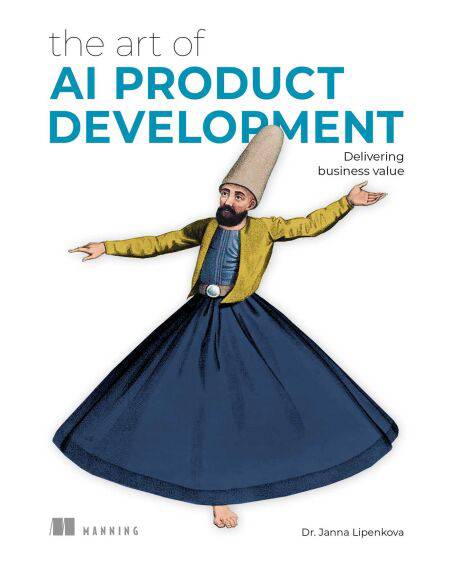
- Retrait gratuit dans votre magasin Club
- 7.000.000 titres dans notre catalogue
- Payer en toute sécurité
- Toujours un magasin près de chez vous
- Retrait gratuit dans votre magasin Club
- 7.000.0000 titres dans notre catalogue
- Payer en toute sécurité
- Toujours un magasin près de chez vous
49,20 €
+ 49 points
Description
A hands-on guide for delivering value with AI-driven products! Learn how AI can improve content creation, accelerate data analysis, and upgrade process automation.
The Art of AI Product Development offers a clear, practical approach to creating products that use AI. It provides real-world guidance on defining your AI strategy, developing useful AI features, and supporting user trust and adoption. Rather than chasing trends, the book focuses on core principles and long-term thinking—foundations that remain relevant as the field evolves.
Inside The Art of AI Product Development, you will learn vital skills for the effective use of AI, including:
• Identifying market and business opportunities for AI
• Gaining an in-depth understanding of modern AI approaches, incl. predictive AI, LLMs, Retrieval-Augmented Generation, and agent systems
• Assembling AI solutions that work, without the hype
• Efficiently communicating with data scientists and ML engineers
• Designing user-friendly AI interfaces that emphasize trust and transparency
• Implementing safe, ethical AI with proper governance processes
The Art of AI Product Development is written for product managers, tech executives, UX designers, and anyone responsible for the success of an AI-driven product. It introduces a broad spectrum of AI opportunities and case studies from different domains such as marketing, supply chain, and logistics. You’ll carefully progress from initial design conversations, through to efficient and secure development, and on to deployment and day-to-day management of AI-driven applications.
About the technology
Integrating AI into your software and processes can create real value for your business and its customers—if you do it right. When you’re on the hook for delivering AI-enabled products, you’ll need to spot high-impact opportunities, work effectively with engineers, design user-centric features, avoid common project failures, and manage real-world launches. This book shows you how.
About the book
The Art of AI Product Development gives you a clear framework, practical tools, and real-world examples to build confidence and succeed with new AI projects—even if you’re tackling AI for the first time. You’ll love the practical use cases and end-to-end scenarios from domains such as marketing, supply chain management, and sustainability.
What's inside
• Ideate, shape, and prioritize AI opportunities
• Develop AI systems with techniques such as prompt engineering, RAG, and predictive AI
• Communicate with different AI stakeholders and promote AI adoption
About the reader
Written for software product managers, business-oriented engineers, UX designers, startup founders, and anyone responsible for developing, designing, or marketing AI products. No experience with AI required.
About the author
Dr. Janna Lipenkova is the founder of an AI and analytics business where she has successfully managed AI projects for world-class companies like BMW, Lufthansa, and Volkswagen.
Table of Contents
Part 1
1 Creating value with AI-driven products
2 Discovering and prioritizing AI opportunities
3 Mapping the AI solution space
Part 2
4 Predictive AI
5 Exploring and evaluating language models
6 Prompt engineering
7 Search and retrieval-augmented generation
8 Fine-tuning language models
9 Automating workflows with agentic AI
Part 3
10 AI user experience: Designing for uncertainty
11 AI governance
12 Working with your stakeholders
Appendix A AI development toolbox
The Art of AI Product Development offers a clear, practical approach to creating products that use AI. It provides real-world guidance on defining your AI strategy, developing useful AI features, and supporting user trust and adoption. Rather than chasing trends, the book focuses on core principles and long-term thinking—foundations that remain relevant as the field evolves.
Inside The Art of AI Product Development, you will learn vital skills for the effective use of AI, including:
• Identifying market and business opportunities for AI
• Gaining an in-depth understanding of modern AI approaches, incl. predictive AI, LLMs, Retrieval-Augmented Generation, and agent systems
• Assembling AI solutions that work, without the hype
• Efficiently communicating with data scientists and ML engineers
• Designing user-friendly AI interfaces that emphasize trust and transparency
• Implementing safe, ethical AI with proper governance processes
The Art of AI Product Development is written for product managers, tech executives, UX designers, and anyone responsible for the success of an AI-driven product. It introduces a broad spectrum of AI opportunities and case studies from different domains such as marketing, supply chain, and logistics. You’ll carefully progress from initial design conversations, through to efficient and secure development, and on to deployment and day-to-day management of AI-driven applications.
About the technology
Integrating AI into your software and processes can create real value for your business and its customers—if you do it right. When you’re on the hook for delivering AI-enabled products, you’ll need to spot high-impact opportunities, work effectively with engineers, design user-centric features, avoid common project failures, and manage real-world launches. This book shows you how.
About the book
The Art of AI Product Development gives you a clear framework, practical tools, and real-world examples to build confidence and succeed with new AI projects—even if you’re tackling AI for the first time. You’ll love the practical use cases and end-to-end scenarios from domains such as marketing, supply chain management, and sustainability.
What's inside
• Ideate, shape, and prioritize AI opportunities
• Develop AI systems with techniques such as prompt engineering, RAG, and predictive AI
• Communicate with different AI stakeholders and promote AI adoption
About the reader
Written for software product managers, business-oriented engineers, UX designers, startup founders, and anyone responsible for developing, designing, or marketing AI products. No experience with AI required.
About the author
Dr. Janna Lipenkova is the founder of an AI and analytics business where she has successfully managed AI projects for world-class companies like BMW, Lufthansa, and Volkswagen.
Table of Contents
Part 1
1 Creating value with AI-driven products
2 Discovering and prioritizing AI opportunities
3 Mapping the AI solution space
Part 2
4 Predictive AI
5 Exploring and evaluating language models
6 Prompt engineering
7 Search and retrieval-augmented generation
8 Fine-tuning language models
9 Automating workflows with agentic AI
Part 3
10 AI user experience: Designing for uncertainty
11 AI governance
12 Working with your stakeholders
Appendix A AI development toolbox
Spécifications
Parties prenantes
- Auteur(s) :
- Editeur:
Contenu
- Nombre de pages :
- 368
- Langue:
- Anglais
- Collection :
Caractéristiques
- EAN:
- 9781638357537
- Date de parution :
- 23-06-25
- Format:
- Ebook
- Protection digitale:
- Adobe DRM
- Format numérique:
- ePub

Les avis
Nous publions uniquement les avis qui respectent les conditions requises. Consultez nos conditions pour les avis.






